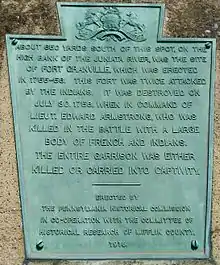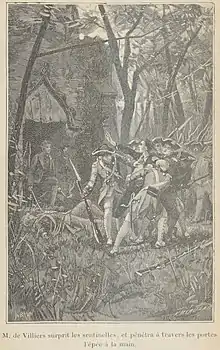Fort Granville
Fort Granville was a militia stockade located in the colonial Province of Pennsylvania. Its site was about a mile from Lewistown, in what is now Granville Township, Mifflin County. Active from 1755 until 1756, the stockade briefly sheltered pioneer settlers in the Juniata River valley during the French and Indian War.[1]
| Fort Granville | |
|---|---|
 1916 state historical marker near Lewistown | |
| Location | Mifflin County, Pennsylvania |
| Coordinates | 40°35′18″N 77°36′5.89″W |
| Built | 1756 |
 Approximate location of Fort Granville | |
Background
After the French victory in the Battle of the Monongahela on July 9, 1755, English settlers on the Pennsylvania frontier were exposed to hostile hit-and-run raids from their adversaries of the Franco-Indian alliance. As the Shawanese and Delawares grew bolder in their excursions in the frontier, it was decided by the provincial government that a string of forts should be constructed across the province from the Delaware Water Gap to the Maryland line. On December 17, 1755, Capt. George Croghan was issued the order below as signed by Benjamin Franklin, Joseph Fox, Joseph Hughs, and Evan Morgan:
Sir:—You are desired to proceed to Cumberland County and fix on proper places for erecting three stockades, viz.: One back of Patterson's, one upon Kishecoquillas, and one near Sideling Hill; each of them fifty feet square, with Block House on two of the corners, and a Barracks within, capable of lodging fifty men. You are also desired to agree with some proper Person or Persons to oversee the workmen at each Place, who shall be allowed such Wages as you shall agree to give, not exceeding one Dollar per day; and the workmen shall be allowed at the rate of six Dollars per month and their Provisions, till the work is finished.[2]
Location and construction
Instead of constructing the fort at the mouth of the Kishacoquillas Creek, Croghan went up the Juniata River to a site near a spring. The exact location can no longer be determined, as the construction of the Pennsylvania Canal destroyed the spring around 1829.[2] According to historian Walter O'Meara, "This fort was an important link in the chain of strongpoints on the west side of the Susquehanna [River], commanding the point where the Juniata falls through the mountains."[1]
Military history

By the summer of 1756, the local settlers only left the fort when absolutely necessary due to an increase in the number of sightings of hostile natives. Assistance arrived under the command of Lt. Armstrong with a militia force to protect them during the harvest. Some of this militia was sent south to Tuscarora to help the settlers there. Around July 22, some sixty to seventy warriors appeared outside the fort ready for battle, but the commanding officer declined to engage in hopes they would dissipate. The Indians fired at one man and wounded him but he was able to get back into the fort with no serious injury. A short distance from the river they killed a man named Baskins, burned his house, and took his wife and children. They also took Hugh Carrol and his family prisoners.[3]
On July 30, Capt. Edward Ward, commandant at Fort Granville, took all but twenty-four men out of the fort to protect settlers in Sherman's Valley, leaving Lt. Edward Armstrong in command at the fort.[2] The natives ascertained the number left behind, and one hundred of them, along with fifty-five Frenchmen,[2][3] led by Francois Coulon de Villiers [4]—not his brother, Louis Coulon de Villiers, as is often written incorrectly—attacked the fort on August 2. "Most of the garrison was away, protecting harvesters in the vicinity; but a Lieutenant Armstrong and 24 men held off the attackers until the next morning."[1]
About midnight, Coulon's men succeeded in setting Fort Granville on fire. Armstrong was shot while trying to extinguish the fire, and the French commander ordered a suspension of hostilities. Coulon offered quarter to the defenders for their surrender several times, but Armstrong would not surrender. He was later shot a second time and succumbed.[3]
Shortly after Armstrong's death, Sergeant John Turner surrendered the fort, garrison, and civilians who had taken refuge inside the stockade. The unfortunate sergeant was made an example of by the victors. They tied him to a stake and "after having heated several old gun barrels red-hot, they danced around him, and every minute or two, seared and burned his flesh... After tormenting him almost to death, they scalped him, and then held up a lad, who ended his sufferings by laying open his skull with a hatchet."[3] The death of Turner was due to a personal feud with an Indian whom he had had badly beaten at a previous time. The captives were taken to Fort de Chartres in the Illinois country, where they were ransomed from the Indians by the French officers and local inhabitants. Escorted to New Orleans, they were then repatriated to England and eventually returned to the American colonies.
Following orders from the French commander, Fort Granville was burnt by Captain Jacobs, leader of the Delaware participants.[5] The French and Indian raid led to retaliation in the form of the Kittanning Expedition, led by Lt. Armstrong's brother, John Armstrong.[1]
See also
References
- O'Meara, Walter (1965). Guns at the Forks. Englewood Cliffs, NJ: Prentice-Hall. p. 174.
- Jordan, John Woolf (1913). A History of the Juniata Valley and Its People. New York, NY: Lewis Historical Publishing Company. pp. 247–250.
- Jones, Uriah James; Egle, William Henry (1889). History of the Early Settlement of the Juniata Valley. Harrisburg, PA: Harrisburg Publishing Company. p. 67.
- Din, G. C. (2000). "Francois Coulon de Villiers: More Light on an Illusive Historical Figure," Louisiana History, vol. 41, no. 3. pp. 345–357.
- Rupp, Israel Daniel (1846). History and Topography of Northumberland, Huntingdon, Mifflin, Centre, Union, Columbia, Juniata and Clinton Counties, PA. Lancaster, PA: Gilbert Hills. p. 105.